New York City Ballet premieres new works by Justin Peck and Pontus Lidberg.
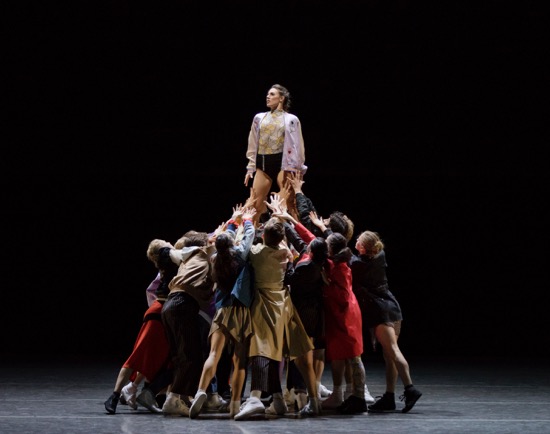
Tiler Peck and the ensemble in Justin Peck’s The Times Are Racing for the New York City Ballet. Photo: Paul Kolnik
When a dance really fascinates me, I wish either that I could immediately see it all over again or that I could be instantly at home, hugging it to myself and processing my memories. Justin Peck’s new The Times Are Racing for the New York City Ballet made me feel this way. It’s set to Dan Deacon’s vivid, changeable, sometime clamorous suite USA 1-4 (“Is a Monster,” “The Great American Desert,” “Rail,” and “Manifest”) from the composer’s electronic and acoustic album, America. According to Peck, his work was influenced in part and late in the game by the current political situation, but the society that he depicts is a hornet’s nest of enigmas. You can be stirred by it without understanding every detail. Or maybe deep down, you understand it.
One of the most potent images that Peck creates is that of a circular cluster of almost all twenty dancers in The Times Are Racing. Dressed in bright colored, sporty, at times shapeless clothes by Humberto Leon (supervised by Marc Happel), they bend over, clinging together, their faces invisible. The effect is that of a giant nest, from which one person is hatched and lifted high, standing straight. Once he or she is set down and absorbed, the others jerk, lean back, and pull away. Then they run to a new spot on the stage and do it all over again, this time lifting a different person. Three times, this happens. A little later they again form a clump, but this time, Tiler Peck walks her way up the group, then falls and is discarded. A couple more times before the end, the people cluster again but no new candidate for being lifted emerges.
As the superb, usually well-groomed NYCB dancers spin hectically around—their trim bodies mostly hidden, their coats or skirts flapping, their feet in sneakers, their hair slightly unkempt—Deacon’s music turns dark and pounding. A hero of sorts (Robert Fairchild) enters, but he’s ready to collapse, does collapse. Two men help him up, and he is confronted by the choreographer himself—who dances at him, as if exhorting him to action, and exits. Temporarily.
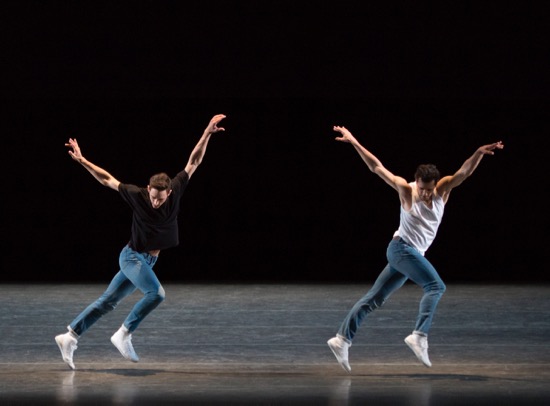
Justin Peck (L) and Robert Fairchild in Peck’s The Times Are Racing. Photo: Paul Kolnik
This relationship is at the heart of the dance. Are these two men alter egos? Friends? Choreographer and dancer? Perhaps all three. (Is it significant that Fairchild and J. Peck were roommates when they were kids at the School of American Ballet?) In a later section, the pair of them (Fairchild no longer discouraged) race forward side by side, dance in vigorous, breezy unison, assume semi-ballroom positions with invisible partners, and indulge in an easy-going soft shoe number to Deacon’s rhythmic bubbling (see Peck’s New York underground video of the two: https://www.youtube.com/watch?v=nj0nltZOf50). As always, I’m drawn to Peck’s way with rhythm and dynamics—with how, say, a brisk, complex bit of footwork leads into a suspension the length of a drawn breath. I notice the ways in which the dancers shift their focus—glancing now behind them, now ahead, now at their feet, now at the sky; it makes them look super-aware and alive to the space they’re in.
They stop in their tracks, standing on one leg, when Tiler Peck and Amar Ramasar come together, then back away offstage to give the pair some privacy. The negotiations between this new duo are anything but standard pas de deux behavior; instead, they have the air of an interesting conversation. There are pauses, one quite long. Tiler Peck and Ramasar stand for a while almost nose to nose. Several times when she happens to lift a leg, he smacks the sole of her foot. She supports him when he assays a handstand. After the others intrude and fall, leaving one leg lifted. Ramasar walks amid this forest of flexed feet, touching now one sole, now another. Glad-handing in a new guise. When everyone pairs up for a while, little attention is paid to gender.
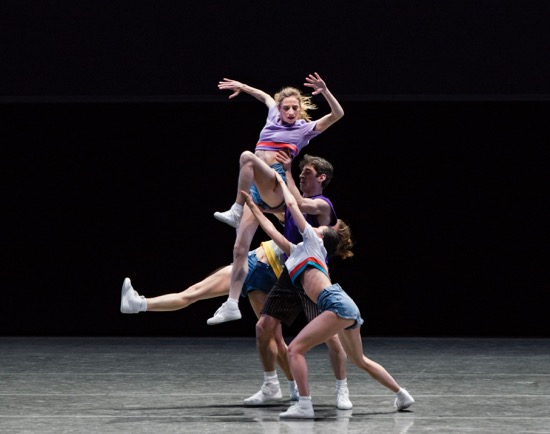
Sean Suozzi hoists Gretchen Smith, helped (?) by Brittany Pollack and Savannah Lowery. Photo: Paul Kolnik
The get-together for Fairchild and J. Peck is preceded by a fine game for Sean Suozzi and three frisky women (Brittany Pollack, Gretchen Smith, and Savannah Lowery). J. Peck may be alluding subtly to Balanchine’s Apollo, but these are earthy muses, and Suozzi is no youthful god, but a wily street kid. When he circles the women, he hunkers down and keeps his eyes on them. The four also “just dance” together, although he ends by yanking them around, one by one, as the music races to a climax. The ensemble is never away for long, and they bridge this quartet and the ensuing duet by sidling onstage in trios—except that the middle person is only any empty coat, held up by it spread-out sleeves.
My memory of the final moment may be flawed, but Fairchild seems stuck somehow, and others have formed a cluster, as in the beginning of The Times Are Racing. J. Peck is waiting for him at its center, and they can’t budge him. Finally he runs and vaults into it. Then everyone falls to the floor.
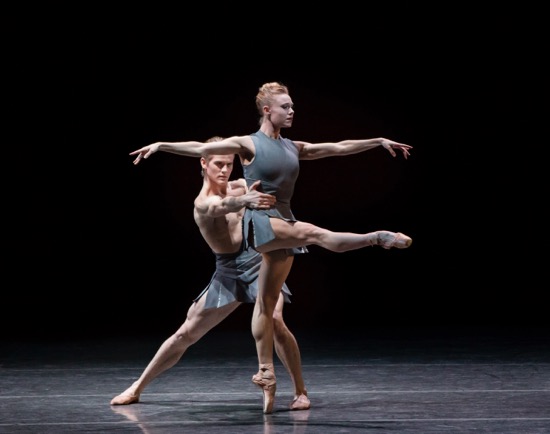
New York City Ballet’s Sara Means and Chase Finlay in Pontus Lidberg’s The Shimmering Asphalt. Photo: Paul Kolnik
Pontus Lidberg choreographed The Shimmering Asphalt for NYCB to David Lang’s Shade, for violin, cello, and piano (Lidberg has collaborated with Lang for over ten years). He was given a dream cast: nine principal dancers and six members of the company’s corps de ballet. Like the titles of both the music and the ballet, the work projects a kind of gritty poetry, and, in keeping with this, Rachel Quarby-Spadaccini has dressed the dancers in gray. The principal men (Chase Finlay, Gonzalo Garcia, Russell Janzen, and Taylor Stanley) wear only short skirts that vaguely resemble those worn by soldier of ancient Rome; the principal women (Sterling Hyltin, Rebecca Krohn, Lauren Lovette, Sara Mearns and Tiler Peck are garbed in tunics with equally short paneled skirts, but theirs are angled and twisted. The costumes of the other six (Emilie Gerrity, Unity Phelan, Indiana Woodward, Harrison Ball, Aaron Sanz, and Peter Walker) are similar.
A few points of light glint on the dark background, and Mark Stanley’s lighting sometimes has the harsh effect of overhead street lights. So, classical steps meet pavement, and it’s the dancers’ job to shimmer flintily, which they do. One of Lidberg’s devices is, from time to time, to station three dancers moving minimally in either the upstage left corner or the downstage right corner, or both, in order to frame the central action.
Although the women in The Shimmering Asphalt are on pointe, that doesn’t stop them from occasionally falling to the floor, and there’s an occasional hint of drama. In the second section, Peck and Stanley are dancing together, when she falls; without looking back, he moves on to Hyltin. But Garcia replaces him with Hyltin for a perky few moments, until, guess what, here’s Lovette ready to dance with Garcia. Any dancers not busy watch the butter-smooth partner switching until it gets contentious.
The floor seems to attract these people. Mearns enters for the third of five sections, and practically the first thing she does is lie down, although she rises to dance in canon with Peck and then to be reverently handled by the four principal men. In the next scene, Hyltin, Krohn, Lovette, and Peck monopolize Stanley for a while.
Lidberg’s choreography sometimes dances around Lang’s music or against it, and the overall effect is of a party at which no one has a very good time. Although every one of the fine principal dancers comes to your attention for a few seconds at least (Krohn, for instance, hastening way through a quietly moving, strung-out group or Peck racing into strangely canted leaps), you find yourself thinking things like, “Where’s Hyltin? We haven’t seen her for a while.” Finally, everyone is onstage together, principals and corps mixed together—some frozen, some stirring, while Mearns and Finlay have a final rendezvous. She’s alone at the end of The Shimmering Asphalt, grave, and accepting whatever is to come.
This isn’t the kind of dance in which the movement itself suggests complex relationships or thoughts. Lidberg shows people adjusting to one another in a landscape where moods and encounters play out as if destined rather than willed.
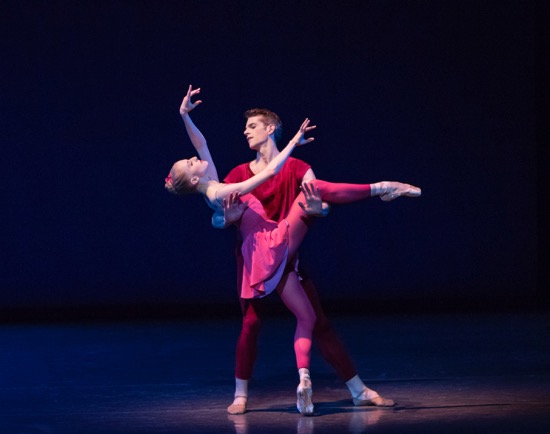
Claire Kreztschmar and Russell Janzen of the New York City Ballet in Peter Martins’ Fearful Symmetries. Photo: Paul Kolnik
The evening on which I saw these two new ballets began with Peter Martins’s 1990 Fearful Symmetries, set to John Adams’s fiercely throbbing score. On the NYCB’s website, Adams is quoted as saying that his ballet is “for sure a seriously aerobic piece, a Pantagruel boogie with a thrusting, grinding beat that governs at least two-thirds of its length.” I’m not sure how Adams was defining Pantagruel—maybe only that this son of Rabelais’ Gargantua was one huge baby. And despite the beat as he defines it, there’s nothing scatological about this ballet. As for the title, which refers to William Blake’s poem with its fiercely symmetrical tiger “burning bright/In the forests of the night,” the only thing I saw burning bright were the dancers: three principal couples, three impressive men, and an ensemble of four couples, plus six women.
These people, dressed by Steve Rubin in trim, color-coded costumes, ranging from red through orange to pink, seem driven by the music. Martins gives us a chance to acclimate to it by letting us sit and listen for several minutes before the curtain rises. I saw the ballet years ago and don’t think I fully realized how aerobic it was. It has barely started before dancers start surging across the stage in big leaps. They’re off the ground a lot—leaping, jumping, hopping, skipping in many different ways. Once, they vault from one leg, flinging the other out to the side. Or they leave the floor, crossing one leg over the other. I think it was Ashly Isaacs, paired with Zachary Catanzaro, who was periodically hoisted up in a froggy position. Claire Kretzschmar and Russell Janzen, Alston Macgill and Harrison Ball also have their ‘burning bright” moments, before all collapse, wake up as the music dwindles, and form a tableau. Macgill was getting what may have been her first big role; programs were rustling; guesses exchanged. Bold, precise, musical, elfin, and a little too wire-thin for her own good, she’s clearly on the rise.
The two new ballets will return again in May during NYCB’s Spring Season.
